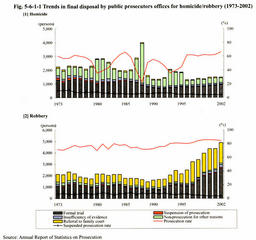| Previous Next Index Image Index Year Selection | |
|
|
1 Disposition by public prosecutors offices Fig. 5-6-1-1 shows the trends in the number of persons finally disposed by public prosecutors offices, the prosecution rate, and the suspended prosecution rate, with respect to homicide/robbery.
The number of persons prosecuted for formal trials for homicide had remained almost unchanged, but has been on a slightly upward trend in the last few years. The prosecution rate differs between 22.2% and 65.9% depending on the year because a considerable number of suspects are "not prosecuted for other reasons" and because the number of such suspects fluctuates. Other reasons are those that make it impossible to punish suspects as offenders, such as being insane, not comprising an offense receivable by public prosecutors offices and lacking evidence, etc. Thus, there are actually only a few cases in which suspects are not prosecuted despite the suspicion of an offense being sufficiently recognized by the evidence. The suspended prosecution rate (rate of suspects who were not prosecuted in the total of suspects, excluding those who were not prosecuted "for other reasons" or "for insufficiency of evidence") has been in the range of 3.7% to 10.7%. In other words, 89.3 to 96.3% of suspects have been prosecuted for formal trial if suspicion of an offence was sufficiently recognized. In addition, the suspended prosecution rate has been relatively low and flat in comparison with other types of offenses, and suspects who are not prosecuted due to insufficient evidence are very few for homicide. Over 90% of suspects have been prosecuted with respect to homicide if sufficient information is collected and the suspicion of an offense is recognized. Unlike homicide, for robbery, the number of persons prosecuted for formal trial and that of persons referred to family courts have been, broadly speaking, on an upward trend since 1996. In 2002, the number of persons prosecuted for formal trial increased about 2.5-fold from that in 1996, while that of persons referred to family courts increased about 1.5-fold. The number of suspects who were not prosecuted for other reasons has been small, and the prosecution rate has been high at 70.2%-85.6%. The suspended prosecution rate has been low at 3.5%-8.8% as with homicide. Very few suspects have not been prosecuted due to insufficiency of evidence. As with homicide, 91.2-96.5% of suspects were prosecuted if sufficient evidence is collected and the suspicion of an offense is sufficiently recognized. As above, heinous offenses such as homicide and robbery are the types of offenses most severely disposed by public prosecutors offices from the viewpoint of protecting victims as well as that of general prevention for preventing offenses and special prevention for preventing offenders from committing repeat offenses. Fig. 5-6-1-1 Trends in final disposal by public prosecutors offices for homicide/robbery (1973-2002) |
